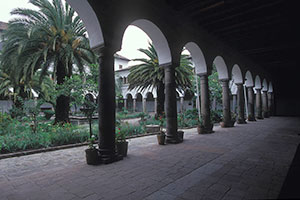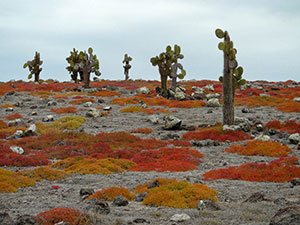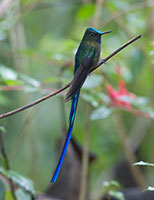Ecuador
 Ecuador is an extraordinarily rich country that includes not only the Galapagos, but also some of the richest Amazon rainforest, complex Andean bioregions, and a highly varied coast and coastal plain area. The coastal area itself stretches from an intense rainforest of over 600 inches of rain per year in the North, to a desert in the south.
Ecuador is an extraordinarily rich country that includes not only the Galapagos, but also some of the richest Amazon rainforest, complex Andean bioregions, and a highly varied coast and coastal plain area. The coastal area itself stretches from an intense rainforest of over 600 inches of rain per year in the North, to a desert in the south.
Ecuador is only about the size of the state of Colorado, making visiting its very diverse regions not only possible, but also efficient. Its biological abundance is truly amazing. Setting on the equator, it has an equatorial summer year round. Yet its higher peaks are covered in snow and ice. Quito experiences eternal spring, and the lowlands can be very warm.
 This varied terrain makes for a birding paradise, with many unique species. For example, there are over 130 kinds of hummingbirds, and its 1600 bird species is over half of all the species in South America; and South America is considered the bird continent with 3,000 species of birds. This alone makes Ecuador one of the biological wonders of the world. Nowhere else is such a diversity of birds found in such a small area! Birds are numerous and can be everywhere, including downtown city parks. If anything, the plant diversity is even more amazing.
This varied terrain makes for a birding paradise, with many unique species. For example, there are over 130 kinds of hummingbirds, and its 1600 bird species is over half of all the species in South America; and South America is considered the bird continent with 3,000 species of birds. This alone makes Ecuador one of the biological wonders of the world. Nowhere else is such a diversity of birds found in such a small area! Birds are numerous and can be everywhere, including downtown city parks. If anything, the plant diversity is even more amazing.
The Amazon Region and the Cloud Forest vie for having the greatest flowering of life on earth! In the Amazon, even gaudy macaws have to scream to be noticed, so intense is the vegetation, with as many as 200 species of trees per hectare (2.5 acres). And with water nearly everywhere, there are more fish species than in the Atlantic Ocean. The pink river dolphins will compete for your attention with numerous monkey species, sloths and other mammals. The western Amazon, near the eastern slope of the Andes has the highest diversity of life anywhere in South America.
To find out more about Ecuador trips please Contact Us
Ecuador
Cloud Forest
 The Cloud Forest near the western slope of the Andes is even more than the Amazon an endemic center of life. It vies with the Amazon for its highly diverse richness of life, but a higher percent of its bird life are found nowhere else on earth – many of them occurring in tiny geographic area within the Cloud Forest. With abundant moisture, epiphytes are everywhere, including orchids, bromeliads, ferns, mosses and more. It is also one of the world’s greatest birding areas and also a favorite of Ronn's. It is possible, for example, to see 30 species of hummingbirds in a day - all within a few miles of each other. In a small area it is possible to see over 250 species of birds but fifty of them or twenty percent are endemic or found no where else. Ecuador has so many hummingbirds they have almost run out of names for them: hermits, lancebills, violetears, fairies, mangos, sunangels, thorntails, hillstars, sylphs, trainbearers, puflegs metaltails, incas, sapphirewing, sword-billeds, starfronlets, and more. I call them feathered jewels. You will call them spectacular. At any of several nearby locations, it is possible to see twenty or more species of hummingbirds, and by changing altitude just a little, the species vary.
The Cloud Forest near the western slope of the Andes is even more than the Amazon an endemic center of life. It vies with the Amazon for its highly diverse richness of life, but a higher percent of its bird life are found nowhere else on earth – many of them occurring in tiny geographic area within the Cloud Forest. With abundant moisture, epiphytes are everywhere, including orchids, bromeliads, ferns, mosses and more. It is also one of the world’s greatest birding areas and also a favorite of Ronn's. It is possible, for example, to see 30 species of hummingbirds in a day - all within a few miles of each other. In a small area it is possible to see over 250 species of birds but fifty of them or twenty percent are endemic or found no where else. Ecuador has so many hummingbirds they have almost run out of names for them: hermits, lancebills, violetears, fairies, mangos, sunangels, thorntails, hillstars, sylphs, trainbearers, puflegs metaltails, incas, sapphirewing, sword-billeds, starfronlets, and more. I call them feathered jewels. You will call them spectacular. At any of several nearby locations, it is possible to see twenty or more species of hummingbirds, and by changing altitude just a little, the species vary.
In addition to bird families you are familiar with in North America, expect to see Trogons and Quetzals, Motmots, and Puffbirds, Antbirds and Woodcreepers. Barbests and Toucans. Or, how about the Toucan Barbet that lives in the yard. You will not only be entertained, you will be fascinated. You don’t even have to be a birder to enjoy the intimacy with these feathered jewels.
The legion of flowering plants will vie for your attention. Every tree seems to support it own garden of ferns, mosses, bromeliads, orchids and vines.
One of the best parts is that the Cloud forest is only a two hour drive from Quito, but a fascinating drive itself, being a transect of the Andes.

